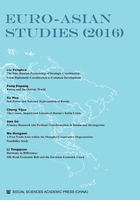
1. Predicament for Russia's economy
At present, economy is mainly confronted with six difficulties.
To begin with, the country's macro-economic indicators underperform. During 2014, Russia's GDP increased slightly by 0.6 percent but four critical economic indicators including residents' real income, fixed asset investment, inflation rate, energy output and export volume were worrisome. Russians' disposable income has declined 1 percent for the first time since 1999. (The figure rose by 8.3 percent annually from 2000 to 2013.) This year also witnessed an obvious fall in fixed asset investment by 2.5 percent. The inflation rate reached as high as 11.4 percent, mainly put up by an increase in food prices that contributed 49.1 percent to inflation. Energy output and export looked bleak: generated power went up 0.1 percent; oil (including condensate gas) yield up by 0.8 percent; oil export volume dropped 6.7 percent; natural gas exploration volume shrunk by 4.3 percent, and export down by 10.9 percent.
Second, tourist industry, aviation and auto sales suffer a lot. Income reduction led to slow growth in consumer demand, in particular in tourism, aviation and car sales. According to materials from the Association of Tour Operators of Russia, Russian people's demand for tourist spending decreased by 40 to 50 percent over 2014, the number of Russian tourists travelling abroad was only half of that of the previous year, and the number of foreign tourists to Russia was also cut by 30 to 40 percent. In 2014 alone 21 travel agencies went bankrupt and it is predicted that 450 more will come across difficulties in operation in 2015. (There are altogether 1380 travel agencies across Russia.) The tourist industry has begun to lay off employees and cut down salaries. Approximately 30 percent of jobholders in this industry will probably leave in 2015. The aviation industry was consequently affected by the fall in people's travel demand. In December 2014, the orders of booking chartered planes for the next summer dropped by 40 percent on a year-on-year basis. Auto sales were another field hit by the consumer demand slide, with a reduction of 12 percent in sales in 2014.
In the third place, Russia's economic prospect looks blue. As of the end of 2014, both the international community and Russia's domestic authority concerned predicted that Russia's oil price would be at $60 per barrel. The Ministry of Economic Development of the Russian Federation gave a relatively sanguine forecast by inferring that Russia's economy would likely resume after one and a half years under the predicted oil prices and the background of the Western economic sanctions. According to it, the economy will see a contraction of 2.5 to 3 percent in 2015 and will not restore growth until the latter half of 2016. The Central Bank of the Russian Federation contended that with the oil price of $60 per barrel and lasting Western sanctions amid geopolitical tensions, the country's economy will probably decline by 4.5 to 4.8 percent in 2015 and by 1 percent in 2016, and it will see a sign of restorative growth of 5.5 to 5.8 percent in 2017. Moody's predicted that the Russia's economy would go down by 5.5 percent and 3 percent in 2015 more in 2016.
Next, the Russian ruble crisis may further unfold. Given the slump in oil prices, Western sanctions, capital flight and less confidence in ruble, the exchange rate of the ruble against the US dollar plummeted by more than 45 percent. To prevent the most severe ruble depreciation since 1998, Russia had to sell its foreign currencies in bulk and meanwhile require its export companies to carry out compulsory settlement of exchange. It also announced the decision to raise the benchmark interest rate from 10.5 percent to 17 percent to deal with the depreciafion of the ruble, with little effect though. Up to January 6, 2015, 64 rubles equaled one US dollar and the Russian currency may further tumble given the further decline in oil prices. In addition, the debt service on external debt of Russian banks and non-financial organizations amounted to $130 billion in 2015. These banks and companies will purchase US dollars and Euros when repaying the principal and interest, which will drive up foreign exchange demand and consequently aggravate the ruble depreciation.
Fifth, revenue from petroleum and natural gas drops and the phenomenon of capital flight intensifies. According to the statistics of the Federal Customs Service of the Russian Government, from January to November in 2014, the export sales of crude oil and natural gas declined by 3.6 percent and 6.5 percent respectively on a year-on-year basis. The Energy Information Administration of the US predicted that Russia would suffer a loss of up to $80 billion in its oil export revenue if the international oil price remains at $60 per barrel over the next year. Putin declared on December 22 that Russia's net capital outflow was estimated at $120 to 130 billion. The Central Bank forecast that the flight capital would be around $99 to 120 billion in 2015, $75 billion in 2016 and $55 billion in 2017.
Last, Russia's sovereign credit rating was cut to junk status. On January 26, 2015, Standard & Poor's ratings agency lowered Russia's sovereign rating to ‘junk' status from BBB- to BB+ with negative outlook, bringing it below investment grade for the first time in a decade. The reason Standard & Poor's gave was that the decreasing stability in Russia's financial system would weaken the flexibility of its monetary and credit policy and therefore fail to ensure the country's steady economic growth. On February 20, Moody's Investors Service downgraded Russia's sovereign debt rating from Baa3 to Ba1, with negative outlook. According to the Moody's, the unfolding Ukrainian crisis, the floundering international oil price, fluctuations in Russia's foreign exchange market, the exacerbating capital outflow and the ongoing sanctions from the US-led West would sink the Russian economy in deep recession and further contraction next year.